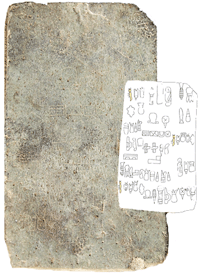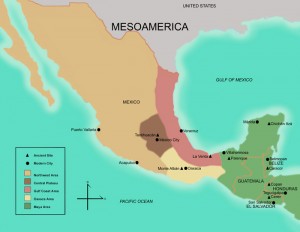At this point in the semester, you might be finding that your class formats are feeling “old.” Maybe you’ve done lots of group discussions, or lots of “pair-share” or lots of lecturing. Time for a list of ideas
Category Archives: Site Feed
Chermaitre in Retrospect: A Student’s Voice
Sarah Oliver is a senior at Vassar College, majoring in Anthropology and pursuing a future career in medicine. In Vassar Haiti Project, Sarah is currently serving as the President of Internal Operations and is an invaluable member of the organization
The Cascajal Block of the Olmec Civilization
Although many people only think of Egyptian hieroglyphics when discussing the origins of written language, there is evidence that written language systems had been developed independently of each other around the world. Artifacts suggests that the earliest forms of written language originated in Mesopotamia, China, and Mesoamerica. A recent find has opened the door for reanalysis and for questioning regarding the early written records of Mesoamerica and their influence in the development of the area’s early languages. In the early 1990s, while building a road, what is now known as the Cascajal Block was found in Veracruz, Mexico, where the Olmec civilization once stood. This stone block was taken care of by cultural authorities and was examined in 1999 and 2006.
Upon examination, archaeologists Carmen Rodriguez and Ponciano Ortiz revealed that the serpentine block contained sixty two images on one of its surfaces. After investigating the images on the block, they believed that an example of written text had been found. The pictures on the block appear to be arranged in a certain syntax, there are patterns and repeating images suggesting that the images are not just art or pictures but written language. Another interesting observation reveals that the block may have cleared or erased several times indicating possible personal use.
Although most agree that the images on the block are indeed evidence of a writing system, some controversy surrounds the dating of the block. The block was dated to around 900 BCE, this estimate was based on the pot sherds and other artifacts it was found with, so many do not trust that the true context of the artifact is known. If the dating holds true, then the Cascajal Block is the earliest evidence of written language in the Americas. This along with the fact that the images do not seem to connect to any other writing of the area or time period has added to the “mother-sister” debate regarding the Olmec civilization’s influence in Mesoamerica.
The discovery of the Cascajal Block and the debates surrounding it can help us understand how different archaeological approaches and circles of thought can be used to gain a deeper understanding of the artifact and the Olmec civilization. Starting with a functionalists approach the block’s possible purposes may be examined, and here experimental archaeology techniques may be used to understand the functionality of the block as a personal writing tool. From this type of investigation, more questions will arise and can be asked. We can approach these questions from a more structuralist or processual view by looking into the social structures of Olmec civilization and how written language, text, and literacy were affected and affected structures such as gender and class or everyday life. With these ideas in mind, what are the possible implication of the Cascajal Block?
References:
http://www.sciencemag.org/content/313/5793/1551.full
http://archive.archaeology.org/0701/etc/learn.html
http://archaeology.about.com/od/olmeccivilization/a/cascajal_block_3.htm
Photo 1: http://archive.archaeology.org/0701/etc/learn.html
Photo 2: http://www.famsi.org/maps/
Additional Reading:
http://www.sciencemag.org/content/313/5793/1610.full
http://archive.archaeology.org/0601/abstracts/olmec.html
Punk Rock, or a Waste of Time?
Punk Archaeology entails the creative use of artifacts and sites to break out of established modes of thought to promote new ways of thinking. Andrew Reinhard, the lead archaeologist in the Atari dig, describes Punk archeology as “the history of places affiliated with Punk music and culture. It also means that as archaeologists, we apply Punk’s do-it-yourself aesthetic to our science. Punk also engages the community and finds ways to work either within or around constraints such as money and time, using those restrictions to our advantage creatively.”There is continuous debate however, over the efficiency of this practice of archeology and why punk archaeology may or may not succeed in challenging established modes of thought.
When looking at the Atari excavations done in New Mexico by a team of punk archaeologists, it is hard not to wonder whether encountering and presenting the buried games as archaeological artifacts had the effect of providing some distance from the familiar and opening these objects up to new forms of critique. While archaeological investigation is in many ways about solving ancient “mysteries” archaeology is, first and foremost, a social science that uses various methodologies, careful accumulation and analysis of data, and scientific method. One of the first cons of the use of Punk archeology is the mass media that it attracts that creates a negative effect on the discoveries made. To clarify, when looking at the Atari dig done in New Mexico, some saw it as merely a publicity stunt and “claim to fame.” Instead of focusing on the actual science being done, such as the exposing of the stratigraphy of the landfill to determine the interplay between domestic trash and dumped Atari products, the project was largely dependent on the overarching story and schedule of the director…not the scientists. The scientists in this project can be viewed as props in “archeology theatre” and just parts of the documentary, not the main focus. This can also cause a lot of what is discovered to be twisted just to be made more appealing to the public. Punk archeology can often lead to forms of pseudoarcheology whereas things such as aliens walking the earth are studied. While some may argue that public attention is good for breaking established thought, putting archeology on a global stage can be detrimental and making it all seem like a big joke.
Punk archaeology can also be seen as a tool that encourages us to approach the familiar in unconventional ways. It complements conventional archaeology which likewise provides a distance for critically understanding objects from the past, but in most cases these objects are already unfamiliar to the modern viewer. Punk archeology can make these objects understandable and relevant to public viewers. In the example of the Atari dig-up, it gave archeology profile and capital while also offering a look into corporate history. Some of what was dug up in this finding became museum artifacts and part of a life history visible to the public eye. Punk archaeology is not only a source of entertaining websites and goofy TV shows, it can be used in much more powerful way to influence modern ideas about the past and the present. It channels the public into learning a great deal about our more recent past and how modern thinking has informed and is informed by ancient history.
Seniors and freshmen approach learning differently
This semester I’m teaching first year students new to college and seniors thinking hard about Life After College. How they approach their classes and their own learning is vastly different. My seniors come to class excited about the hard work … Continue reading →


